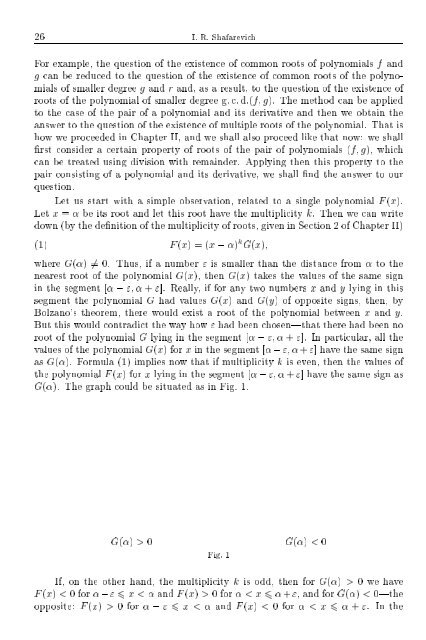SELECTED CHAPTERS FROM ALGEBRA I. R. Shafarevich Preface
SELECTED CHAPTERS FROM ALGEBRA I. R. Shafarevich Preface
SELECTED CHAPTERS FROM ALGEBRA I. R. Shafarevich Preface
You also want an ePaper? Increase the reach of your titles
YUMPU automatically turns print PDFs into web optimized ePapers that Google loves.
26 I. R. <strong>Shafarevich</strong>For example, the question of the existence of common roots of polynomials f andg can be reduced to the question of the existence of common roots of the polynomialsof smaller degree g and r and, as a result, to the question of the existence ofroots of the polynomial of smaller degree g: c: d:(fg). The method can be appliedto the case of the pair of a polynomial and its derivative and then we obtaintheanswer to the question of the existence of multiple roots of the polynomial. That ishow we proceeded in Chapter II, and we shall also proceed like thatnow: we shallrst consider a certain property ofroots of the pair of polynomials (fg), whichcan be treated using division with remainder. Applying then this property tothepair consisting of a polynomial and its derivative, we shall nd the answer to ourquestion.Let us start with a simple observation, related to a single polynomial F (x).Let x = be its root and let this root have themultiplicity k. Then we can writedown (by the denition of the multiplicity ofroots,given in Section 2 of Chapter II)(1) F (x) =(x ; ) k G(x)where G() 6= 0. Thus, if anumber " is smaller than the distance from to thenearest root of the polynomial G(x), then G(x) takes the values of the same signin the segment [ ; " + "]. Really, if for any two numbers x and y lying in thissegment the polynomial G had values G(x) and G(y) of opposite signs, then, byBolzano's theorem, there would exist a root of the polynomial between x and y.But this would contradict the way how " had been chosen|that there had been noroot of the polynomial G lying in the segment [ ; " + "]. In particular, all thevalues of the polynomial G(x) forx in the segment [ ; " + "] have the same signas G(). Formula (1) implies now thatifmultiplicity k is even, then the values ofthe polynomial F (x) forx lying in the segment [ ; " + "] have the same sign asG(). The graph could be situated as in Fig. 1.G() > 0 G() < 0Fig. 1If, on the other hand, the multiplicity k is odd, then for G() > 0 we haveF (x) < 0 for ;" 6 x 0 for
















